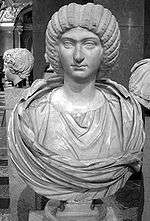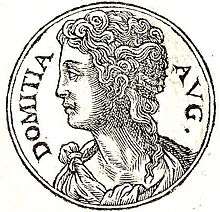Women in ancient warfare
The role of women in ancient warfare differed from culture to culture. While warriors have historically always been overwhelmingly male, there have been various historical accounts of females participating in battle.

Amazonomachy battle between Greeks and Amazons, relief of a sarcophagus – c. 180 BCE, found in Thessaloniki, 1836, now in the Louvre, Department of Greek Antiquities
This article lists instances of women recorded as participating in ancient warfare, from the beginning of written records to approximately 500 CE. Contemporary archaeological research regularly provides better insight into the accuracy of ancient historical accounts.
Timeline of women in ancient warfare worldwide

18th century depiction of Thaïs
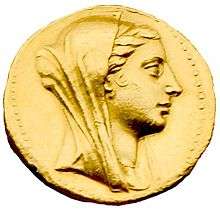
Arsinoe III of Egypt

Cleopatra II
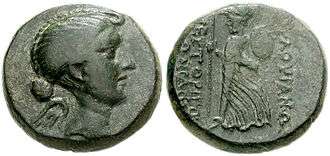
Fulvia of Roman Empire
Statue of the Trung sisters in Ho Chi Minh City
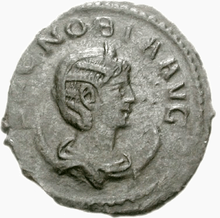
Coin depicting Zenobia

Folk art depiction of Lady Triệu
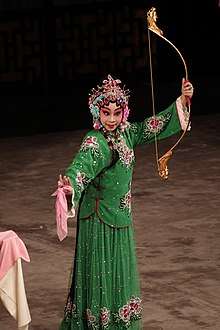
Xun Guan portrayed by a Peking opera actress during a 2015 performance in Tianchan Theatre, Shanghai, China.
17th century BCE
- 17th century BCE – Ahhotep I is credited with a stela at Karnak for "having pulled Egypt together, having cared for its army, having guarded it, having brought back those who fled, gathering up its deserters, having quieted the South, subduing those who defy her".[1]
- Ahhotep II is buried with a dagger and axe, as well as three golden fly pendants, which were given as rewards for military valor. However, it is debated as to whether or not they actually belong to her.[2]
15th century BCE
- 1479 BCE – 1458 BCE[3] – Reign of Hatshepsut. It is possible that she led military campaigns against Nubia and Canaan.[4]
13th century BCE
- 13th century BCE[5] – Estimated time of the Trojan War. According to ancient sources, several women participate in battle (see Category:Women of the Trojan war). Epipole of Carystus is one of the first women who are reported to have cross-dressed as men to fight in a war.
- 13th century BCE – Lady Fu Hao consort of the Chinese emperor Wu Ding, led 3,000 men into battle[6] during the Shang Dynasty. Fu Hao had entered the royal household by marriage and took advantage of the semi-matriarchal slave society to rise through the ranks.[7] Fu Hao is known to modern scholars mainly from inscriptions on Shang Dynasty oracle bone artifacts unearthed at Yinxu.[8] In these inscriptions she is shown to have led numerous military campaigns. The Tu fought against the Shang for generations until they finally were defeated by Fu Hao in a single decisive battle. Further campaigns against the neighbouring Yi, Qiang, and Ba followed, the latter is particularly remembered as the earliest recorded large scale ambush in Chinese history. With up to 13,000 troops and the important generals Zhi and Hou Gao serving under her, she was the most powerful military leader of her time.[9] This highly unusual status is confirmed by the many weapons, including great battle-axes, unearthed from her tomb.[10] One of Wu Ding's other wives, Fu Jing, also participated in military expeditions.[11]
- Vedic period (1200–1000 BCE) roughly – The Rigveda (RV 1 and RV 10) hymns mention a female warrior named Vishpala, who lost a leg in battle, had an iron prosthesis made, and returned to warfare.[12]
11th century BCE
- 11th century BCE[13] – According to Geoffrey of Monmouth, Queen Gwendolen fought her husband, Locrinus, in battle for the throne of Britain. She defeated him and became the monarch.[14] However, Geoffrey of Monmouth is not considered a reliable historical source.[15]
- 11th century BCE – 4th century CE – Approximate time for the burial of a Kangju woman in modern Kazakhstan who was buried with a sword and a dagger.[16]
10th century BCE
9th century BCE
- Late 9th century BCE – 8th century BCE – Shammuramat (Semiramis) ruled the Neo-Assyrian Empire.[22][23] She was the first woman to rule an empire without a man ruling with her.[24] She is believed to have been the inspiration for the legendary warrior queen Semiramis.[25]
- Late 9th century – 8th century BCE[26] – According to Geoffrey of Monmouth, Queen Cordelia, on whom the character in Shakespeare's King Lear is based, battled her nephews for control of her kingdom.[27] However, Geoffrey of Monmouth is not considered a reliable historical source.[15]
8th century BCE
7th century BCE
- 660 BCE – Lady Xu Mu is credited with saving the state of Wey from military invasion with her appeals for aid. The Wey people remembered her for bringing supplies, getting military aid and rebuilding the state. She is also the first recorded female poet in Chinese history.[32]
- 654 BCE – Lampsacus is founded by the Greeks.[33] According to Greek legendary history, written centuries later, a Bebryces woman named Lampsace informed the Greeks of a plot against them by the Bebryces, and thus enabled them to conquer the area and found the city, which was named in her honor. She was deified and worshiped as a goddess.[34][35][36]
6th century BCE
- 6th through 4th century BCE – Women are buried with weapons as well as jewelry on the Kazakhstan-Russia border at roughly this time.[37]
- 6th century BCE[38] – Pheretima (Cyrenaean Queen) leads a military.[39][40][41][42][43]
- 580 BCE – Massagetae Queen Tomyris led an army that defeated a Persian army under Cyrus the Great. Tomyris would be known forever after as "the killer of Cyrus".[44][45][46]
- 510 BCE – Greek poetess Telesilla defended the city of Argos from the Spartans.[47][48][49][50][51]
- 506 BCE – Cloelia, a Roman girl[52] who was given as a hostage to the Etruscans, escaped her captors and led several others to safety.[53]
5th century BCE
- 5th century BCE – The Lady of Yue trained the soldiers of the army of King Goujian of Yue.[54]
- 480 BCE – Artemisia I of Caria, Queen of Halicarnassus, was a naval commander and advisor to Xerxes at the Battle of Salamis.[55][56][57]
- 480 BCE[58] – Greek diver Hydna and her father sabotaged enemy ships before a critical battle, thus causing the Greeks to win.[59]
- 460–425 BCE [60] – Greek historian Herodotus[61] described Scythian Amazons.[62] Historian Herodotus,[63] recorded that queen Tomyris of the Massagetae fought and defeated Cyrus the Great.[64] He also records the Zaueces people of Ancient Libya, whom he describes as having their women drive their chariots to war, as well as the festival of Athena Tritogenia among the Ausean people, whose young women are divided into two groups and fight each other with stones and sticks.[65] This festival, taking place in Ancient Libya, describes the girls from the Machlyans and Auseans tribes fighting each other, and those who died were labeled false virgins.[66]
- 460–370 BCE – Approximate lifetime of Hippocrates,[67] who wrote of the Sauromatae, Scythian women fighting battles.[68]
- Late 400s:[69] Ctesias records the story of Zarinaea, a Sacae woman who participated in battle.[70]
- 403–221 BCE – During the Warring States period of China,[71] Sun Tzu wrote a contemporary report of how Ho Lu, King of Wu, tested his skill by ordering him to train an army of 180 women.[72]
4th century BCE
- 4th century BCE – Onomaris is estimated to have lived at around this time period.[73] According to Tractatus De Mulieribus, she led her people in migration to a new land and conquered the local inhabitants.[74]
- 4th century BCE – Cynane, a half-sister to Alexander the Great, accompanied her father on a military campaign and killed an Illyrian leader named Caeria in hand-to-hand combat, and defeated the Illyrian army.[75]
- 4th century BCE[76] – Pythagorean philosopher, Timycha, was captured by Sicilian soldiers during a battle. She and her husband were the only survivors. She is admired for her defiance after capture, because while being questioned by the Sicilian tyrant, she bit off her tongue and spat it at his feet.[77]
- 4th century BCE – Chinese statesman Shang Yang wrote The Book of Lord Shang,[78] in which he recommended dividing the members of an army into three categories; strong men, strong women, and the weak and old of both sexes. He recommended that the strong men serve as the first line of defence, that the strong women defend the forts and build traps, and that the weak and elderly of both sexes control the supply chain. He also recommended that these three groups not be intermingled, on the basis that doing so would be detrimental to morale.[79]
- 4th century BCE - Artemisia II of Caria led a fleet and played a role in the military-political affairs of the Aegean after the decline in the Athenian naval superiority.
- 339 BCE – Mania became of satrap Dardanus.[80] Polyaenus described her as going into battle riding in a chariot, and as being such an excellent general that she was never defeated.[81]
- 335 BCE – Timoclea, after being raped by one of Alexander the Great's soldiers during his attack on Thebes, pushed her rapist down a well and killed him. Alexander was so impressed with her cunning in luring him to the well that he ordered her to be released and that she not be punished for killing his soldier.[82]
- 333 BCE – Stateira I accompanied her Darius III while he went to war. It was because of this that she was captured by Alexander the Great after the Battle of Issus at the town of Issus.[83] Other female family members, including Drypetis, Stateira II, and Sisygambis were present and were captured as well.[84]
- 332 BCE – The Nubian queen, Candace of Meroe, intimidated Alexander the Great with her armies and her strategy while confronting him, causing him to avoid Nubia, instead heading to Egypt, according to Pseudo-Callisthenes.[85] However, Pseudo-Callisthenes is not considered a reliable source, and it is possible that the entire event is fiction.[86] More reliable historical accounts indicate that Alexander never attacked Nubia and never attempted to move farther south than the oasis of Siwa in Egypt.[87]
- 331 BCE– Alexander the Great and his troops burned down Persepolis several months after its capture; traditionally Thaïs (a hetaera who accompanied Alexander on campaigns) suggested it when they were drunk, but others record that it had been discussed previously.[88]
- January 330 BCE – Youtab fights against Greek Macedonian King Alexander the Great at the Battle of the Persian Gate.[89]
- 320s BCE – Cleophis surrendered to Alexander the Great after he laid siege her city.[90][91]
- 318 BCE – Eurydice III of Macedon fought Polyperchon and Olympias.[92]
- 314 BCE – 308 BCE – Cratesipolis commanded an army and forced cities to submit to her.[93][94]
3rd century BCE
- Early 3rd century BCE – Legendary Empress Jingu of Japan may have led an invasion against Korea at this time, however, the story is regarded as fictional by many scholars.[95]
- Early 3rd century BCE – Huang Guigu acted as a military official under Qin Shi Huang. She led military campaigns against the people of northern China.[96]
- 3rd century BCE – Graves of women warriors buried at during this period were found near the Sea of Azov.[97]
- 3rd century BCE – Stratonice of Macedon revolts against Seleucus II Callinicus.[98][99][100][101]
- 295 BCE – Phila (daughter of Antipater) was besieged in Salamis, Cyprus by the king of Egypt Ptolemy I, and ultimately compelled to surrender, but was treated by him in the most honourable manner and sent together with her children in safety to Macedonia.
- 279 BCE – During the Gallic Invasion of Greece a large Gallic force entered Aetolia. Women and the elderly joined in its defense.[102]
- 272 BCE – When Pyrrhus attacked Sparta, the women of the city assisted in the defense, assisted by Chilonis.[103][104][105]
- 272 BCE – Spartan princess Arachidamia leads Spartan women in the construction of a defensive trench and in the aiding of the wounded in battle during the siege of Pyrrhus.[106][107]
- 272 BCE – Pyrrhus of Epirus, the conqueror and source of the term pyrrhic victory, according to Plutarch died while fighting an urban battle in Argos when an old woman threw a roof tile at him, stunning him and allowing an Argive soldier to kill him.[108]
- 220 BCE - Vaccaei and Vetton women fought in the siege of Salmantica against Hannibal. The inhabitants pretended to give up the city, but the women carried hidden weapons in their clothings while they exited, and once outside they armed themselves and the men and attacked the Carthaginians. One of the women disarmed the Carthaginian interpreter, Banno, and attacked him with his own spear. Many of the Salmantines managed to reach the mountains, from where they negotiated with Hannibal. The latter was so impressed that he gave them back their city.[109]
- 220 BCE - Cisalpine Gaul women served as judges in their people's disputes with Hannibal.[110]
- 219 BCE - A possibly fictitious Libyan princess named Asbyte fights for Hannibal at the Siege of Saguntum along with an entourage of horsewomen and war charioteers.[111][112][113]
- 217 BCE – Arsinoe III of Egypt accompanied Ptolemy IV at the Battle of Raphia. When the battle went poorly, she appeared before the troops and exhorted them to fight to defend their families. She also promised two minas of gold to each of them if they won the battle, which they did.[114]
- 216 BCE – Busa of Canosa di Puglia is recorded as aiding soldiers fleeing Hannibal.[115][116][117]
- 206 BCE - Iberian women assisted in the siege of Illiturgis against Scipio Africanus.[118]
- 206–202 BCE - Consort Yu accompanies Xiang Yu on all battles during the Chu–Han Contention.[119]
2nd century BCE
- 2nd century BCE – Queen Stratonice convinced Docimus to leave his stronghold, and her forces took him captive.[120]
- 2nd century BCE – The Book of Judith was probably written at this time.[121] It describes Judith as assassinating Holofernes, an enemy general.[122] However, this incident is regarded by historians fictional due to the historical anachronisms within the text.[123]
- Late 2nd century BCE[124] – Amage, a Sarmatian queen, attacked a Scythian prince who was making incursions onto her protectorates. She rode to Scythia with 120 warriors, where she killed his guards, his friends, his family, and ultimately, killed the prince himself. She allowed his son to live on the condition that he obey her.[125]
- 186 BCE – Chiomara, a Galatian princess, was captured in a battle between Rome and the Galatians and was raped by a centurion. After a reversal she ordered him killed by her companions, and she had him beheaded after he was dead. She then delivered his head to her husband.[126]
- 2nd century BCE – Queen Rhodogune of Parthia was informed of a rebellion while preparing for her bath. She vowed not to brush her hair until the rebellion was ended. She waged a long war to suppress the rebellion, and won it without breaking her vow.[127]
- 138 BCE – The Roman Decimus Junius Brutus found that in Lusitania the women were "fighting and perishing in company with the men with such bravery that they uttered no cry even in the midst of slaughter". He also noted that the Bracari women were "bearing arms with the men, who fought never turning, never showing their backs, or uttering a cry."[128]
- 131 BCE -Cleopatra II led a rebellion against Ptolemy VIII in 131 BCE, and drove him and Cleopatra III out of Egypt.[129]
- 102 BCE – A battle between Romans and the Teutonic Ambrones at Aquae Sextiae took place during this time. Plutarch described that "the fight had been no less fierce with the women than with the men themselves... the women charged with swords and axes and fell upon their opponents uttering a hideous outcry." The women attacked both the Romans and the Ambrones who tried to desert.[130]
- 102/101 BCE[131] – General Marius of the Romans fought the Teutonic Cimbrians. Cimbrian women accompanied their men into war, created a line in battle with their wagons and fought with poles and lances,[132] as well as staves, stones, and swords.[133] When the Cimbrian women saw that defeat was imminent, they killed their children and committed suicide rather than be taken as captives.[134]
1st century BCE
- 1st century BCE[135] – Hypsicratea fights in battles.[136]
- 41–40 BCE – Fulvia becomes involved in the Perusine War. The extent of her involvement is not agreed upon by scholars.[137]
- 27 BCE – 21 BCE – Amanirenas led the Kushite armies against the Romans.[138][139]
1st century CE
- 1st century - There were detailed reports of women accompanying their men on Germanic battlefields to provide morale support. Tacitus mentions them twice; in his Germania and again in his Annals, specifically at the battle near modern Nijmegen when the XV Primigenia and V Alaudae legions were sent packing back to Castra Vetera where they were later besieged during the Revolt of the Batavi. He writes in detail how the women would gather behind the warhost, and show their breasts to flagging warriors while screaming that their loss that day would mean the enemy gaining these as slaves. Women held an honored position in German tribes, and were seen as holy spirits as shown by their adoration of such as Aurinia and Veleda. Slavery was the fate of cowards and the unlucky - and letting one's women fall into that fate was a hideous deed. Thus the men were encouraged to fight harder.[140]
- 1st century – A Sarmatian woman was buried with weapons in what is now modern Russia.[141]
- 1st century – A woman was entombed with a sword in Tabriz, Iran. The tomb was discovered in 2004.[142]
- 1st century – Cartimandua, queen of the Brigantes, allied with the Roman Empire against other Britons.[143]
- 1st century: The historian Tacitus wrote that Triaria, wife of Lucius Vitellius the younger, was accused of having armed herself with a sword and behaved with arrogance and cruelty while at Tarracina, a captured city.[144][145]
- 1st century: There are several historical Roman references to female gladiators from this time period.[146]
- 1st century – 5th century: Four women were buried in Phum Snay, Cambodia with metal swords. The graves date approximately from this time period, and were discovered in 2007.[147]
- 14–18 – Lu Mu, a Chinese peasant also known as Mother Lu, led a rebellion against Wang Mang.[148]
- 15 – Agrippina the elder defends a bridge upon the Rhine.[149]
- 21 – Debate erupted as to whether or not the wives of Roman governors should accompany their husbands in the provinces. Caecina Severus said that they should not, because they "paraded among the soldiers" and that "a woman had presided at the exercises of the cohorts and the manoeuvres of the legions".[150]
- 40 – The Trung Sisters revolt against the Chinese in Vietnam.[151] Phung Thi Chinh joins them.[152]
- 60 - According to Tacitus, druidesses among the Britannian lines waged psychological warfare against the Roman forces in the island of Mona.[153]
- 60–61 – Boudica, a Celtic queen of the Iceni in Britannia, led a massive uprising against the occupying Roman forces.[154] According to Suetonius, her enemy Gaius Suetonius Paulinus encouraged his soldiers by joking that her army contained more women than men, implying the presence of warrior women.[155]
- 69–70 – Veleda of the Germanic Bructeri tribe wielded a great deal of influence in the Batavian rebellion. She was acknowledged as a strategic leader, a priestess, a prophet, and as a living deity.[156]
2nd century CE
- In this time period,[157] Pausanias describes a sacrificial feast to Ares Gynaecothoenas in Tegea in which only women are allowed to participate, due to them having defeated Lacedaemonians without male help.[158]
- 170–174: Faustina the Younger accompanies her husband to war in Germany, and is hailed as "Mother of the Army" after one of his victories.[159]
- 195 – Julia Domna accompanied her husband, Emperor Septimius Severus, in his campaigns in Mesopotamia.[160]
3rd century CE
- 3rd century – Zenobia, the queen of Palmyra, led armies into battle against the Roman Empire.[161]
- 271 – A group of Gothic women, who were captured by Romans while fighting in the same garb as their male peers, were paraded through Rome wearing signs that said, "Amazons".[162]
- 210s - Wang Yi (wife of Zhao Ang) participated in multiple battles alongside her husband against the warlord Ma Chao.[163][164]
- 240s - Women are described as fighting amongst the cavalry ranks of the Sasanian Empire under Shapur I, dressed and armed like men.[165]
- 248 – Trieu Thi Trinh led a rebellion against the Chinese in Vietnam.[166]
- Jin dynasty (265–420): During this time period in China, Xun Guan famously led a group of soldiers into battle at the age of thirteen. As daughter of the governor of Xiangyang she is said to have broken through enemy lines to assemble reinforcements and prevent the city of Xiangyang from being invaded.[167]
4th century CE
- 4th century – As military commander for the Emperor of China, Li Xiu took her father's place and defeated a rebellion.[168]
- 368-370 – Queen Pharantzem defends the fort Artogeressa against the Persion army of Shapur II. [169]
- 375[170] – the arab Queen Mavia led troops against the Romans.[171]
- 378 – Roman Empress Albia Dominica organized her people in defense against the invading Goths after her husband had died in battle.[172]
5th century CE
- 450 – A Moche woman was buried with two ceremonial war clubs and twenty-eight spear throwers. The South American grave is discovered in 2006, and is the first known grave of a Moche woman to contain weapons.[173]
- 4th–6th century: Possible time period that the legendary woman warrior Hua Mulan may have lived.[174]
See also
- Women in post-classical warfare
- Women in warfare (1500–1699)
- Women in 18th-century warfare
- Timeline of women in 19th century warfare
- Women warriors in literature and culture
References
- Rice, Michael (1999). Who's Who in Ancient Egypt. London and New York City: Routlage. p. 3. ISBN 0-415-15448-0.
Who's Who in Ancient Egypt. Routlage. p. 3.
- Graves-Brown, Carolyn (2010). Dancing for Hathor: Women in Ancient Egypt. London and New York City: Continuum Books. p. 39. ISBN 978-1-8472-5054-4.
- Gender in Pre-Hispanic America, edited by Cecelia F. Klein, 2001 p.309
- Bunson, Margaret (2002) [1991]. Encyclopedia of Ancient Egypt (hardcover revised ed.). New York, New York: Facts on File Books. p. 161. ISBN 0-8160-4563-1.
- Mandzuka, Mandzuka. Demystifying the Odyssey. p. 100.
- Peterson, Barbara Bennett, editor in chief; He Hong Fei; Wang Jiu; Han Tie; Zhang Guangyu; Associate editors (2000). Notable Women of China: Shang Dynasty to the Early Twentieth Century. M.E. Sharpe Inc., New York. p. 13. ISBN 0-7656-0504-X.
- "Woman General Fu Hao". All China Women's Federation. Archived from the original on February 14, 2007. Retrieved August 4, 2007.
- "The Tomb of Lady Fu Hao" (PDF). British Museum. Archived (PDF) from the original on September 28, 2007. Retrieved August 4, 2007.
- "Fu Hao – Queen and top general of King Wuding of Shang". Color Q World. Archived from the original on July 4, 2007. Retrieved August 4, 2007.
- Buckley Ebrey, Patricia. "Shang Tomb of Fu Hao". A Visual Sourcebook of Chinese Civilization. University of Washington. Archived from the original on August 13, 2007. Retrieved August 4, 2007.
- Zhou 周, Ying 英 (2014). "中国古代女性阅读史分期述略" [A brief introduction to the stages of Ancient Chinese womens' written histories]. Xinshi Jitu Shiguan (in Chinese) (8): 75–78.
- "A Brief Review of the History of Amputations and Prostheses Earl E. Vanderwerker, Jr., M.D. JACPOC 1976 Vol 15, Num 5". Archived from the original on October 14, 2007. Retrieved January 27, 2007.
- Mountain, Harry (1997). The Celtic Encyclopedia, Volume 3. Upublish.com. p. 729. ISBN 1-58112-893-2.
- Geoffrey of Monmouth, translated and edited by Michael A. Faletra (2008). The History of the Kings of Britain. Toronto, Canada: Broadview Press. pp. 59–62. ISBN 978-1-55111-639-6.
- Princes in Exile By Richard Denning, p.302
- "Ancient 'warrior princess' skeleton found in Kazakhstan". August 11, 2015. Archived from the original on January 20, 2018. Retrieved April 5, 2018.
- Things Can Only Get Feta: Two Journalists and Their Crazy Dog Living Through the Greek Crisis By Marjory McGinn
- Scholia on Euripides, Orestes, 932
- Pausanias, Description of Greece, 4. 1. 1 – 2
- Pausanias, Description of Greece, 4. 3. 9
- Pausanias, Description of Greece, 4. 31. 11
- "Britannica.com". Encyclopædia Britannica. Archived from the original on October 10, 2014. Retrieved October 6, 2014.
- Reilly, Jim (2000) "Contestants for Syrian Domination" in "Chapter 3: Assyrian & Hittite Synchronisms" The Genealogy of Ashakhet Archived March 11, 2012, at the Wayback Machine;
- "City native donates statue of ancient Assyrian ruler". Archived from the original on October 10, 2014. Retrieved October 6, 2014.
- Gera, Deborah (1997). Warrior Women: The Anonymous Tractatus De Mulieribus. E.J. Brill, Leiden, the Netherlands. p. 69. ISBN 90-04-10665-0.
- Shakespeare the Thinker By Anthony David Nuttall p.300
- Geoffrey of Monmouth, translated and edited by Michael A. Faletra (2008). The History of the Kings of Britain. Toronto, Canada: Broadview Press. pp. 64–68. ISBN 978-1-55111-639-6.
- Bryce, Trevor (2012). The World of The Neo-Hittite Kingdoms: A Political and Military History. Oxford University Press, Oxford. p. 270. ISBN 978-0-19-921872-1.
- Cooper, W.R. (1876). An Archaic Dictionary: Biographical, Historical, and Mythological, from the Egyptian, Assyrian, and Etruscan Monuments and Papyri. Samuel Bagster and Sons, 15 Pater Noster Row, London. p. 484.
- Ephʻal, Israel (1982). The Ancient Arabs: Nomads on the Borders of the Fertile Crescent 9th-5th Centuries B.C. Brill. ISBN 978-965-223-400-1.
- Leick, Gwendolyn (2001). Who's Who in the Ancient Near East (Illustrated ed.). Routledge. pp. 85–86. ISBN 978-0-415-13231-2.
- Bennet Peterson, Barbara (2000). Notable Women of China: Shang Dynasty to the Early Twentieth Century. M.E. Sharpe, Inc. p. 21.
- The Companion Guide to Istanbul and Around the Marmara By John Freely, p.346
- Plutarch, On the Virtues of Women, 18 Archived October 18, 2014, at the Wayback Machine
- Polyaenus, Stratagems of War, 8. 37 Archived October 6, 2014, at the Wayback Machine
- Stephanus of Byzantium s. v. Lampsakos: "Lampsacus, a city in Propontis, [named] after Lampsace, a local girl"
- "When death makes them warriors by Kalpish Ratna, Deccan Herald, May 23, 2006".
- A manual of ancient history By George Rawlinson https://books.google.com/books?id=1p8NAAAAQAAJ&pg=PA165&dq=Pheretima+BC+army&hl=en&sa=X&ei=Iio1VJv4HtezyATm_oHYAw&ved=0CCYQ6AEwAA#v=onepage&q=Pheretima%20BC%20army&f=false
- Herodotus, The Histories, Book 4
- Morkot, R., The Penguin Historical Atlas of Ancient Greece, Penguin Books, The Bath Press - Avon, Great Britain, 1996
- "A Dictionary of Greek and Roman Geography, by William Smith (1873) - Cyrene". Archived from the original on October 13, 2014. Retrieved October 8, 2014.
- "Polyaenus: Stratagems - Book 8 (B)". Archived from the original on October 6, 2014. Retrieved July 9, 2014.
- F. Altheim und R. Stiehl, Geschichte Mittelasiens im Altertum (Berlin, 1970), pp. 127–8
- Karasulas, Antony. Mounted Archers Of The Steppe 600 BC-AD 1300 (Elite). Osprey Publishing, 2004, ISBN 978-1-84176-809-0, p. 7.
- Grousset, René. The Empire of the Steppes. Rutgers University Press, 1989, ISBN 0-8135-1304-9, p. 547.
- Chisholm, Hugh, ed. (1911). "Telesilla". Encyclopædia Britannica (11th ed.). Cambridge University Press.
- "Pausanias: Description of Greece, ARGOLIS- 2.20.8". Archived from the original on October 17, 2014. Retrieved October 6, 2014.
- "Pausanias: Description of Greece, ARGOLIS- 2.20.9". Archived from the original on December 3, 2011. Retrieved October 6, 2014.
- Plutarch • On the Bravery of Women — Sections I‑XV
- Plant, Ian Michael (2004). Women Writers of Ancient Greece and Rome: An Anthology - Google Books. ISBN 9780806136219. Archived from the original on October 28, 2013. Retrieved October 9, 2016.
- Fant, M.B. & Lefkowitz, M.R. (2005). Women's Life in Greece and Rome: A Source Book in Translation. Johns Hopkins University Press, Baltimore, Maryland. p. 131. ISBN 0-8018-8310-5.
- Smith, William, LLD., ed. (1867). Dictionary of Greek and Roman Biography and Mythology. Boston: Little, Brown, and Company. volume 1, p.214.CS1 maint: multiple names: authors list (link) CS1 maint: extra text: authors list (link)
- Lee, Lily Xiao Hong; Stefanowska, A.D., eds. (2007). Biographical Dictionary of Chinese Women: Antiquity Through Sui, 1600 B.C.E.-618 C.E. M.E. Sharpe. p. 91. ISBN 978-0-7656-1750-7.
- Polyaenus: Stratagems- BOOK 8, 53.5 Archived October 6, 2014, at the Wayback Machine "Artemisia, queen of Caria, fought as an ally of Xerxes against the Greeks."
- Herodotus Book 8: Urania, 68 Archived June 4, 2014, at the Wayback Machine "...which have been fought near Euboea and have displayed deeds not inferior to those of others, speak to him thus:..."
- N.S. Gill. "Herodotus Passages on Artemisia of Halicarnassus". About. Archived from the original on October 10, 2014. Retrieved October 6, 2014.
- United States Naval Institute Proceedings, Volume 68, 1942, p.662
- A New Classical Dictionary of Greek and Roman Biography Mythology and Geography, By Sir William Smith, Charles Anthony LLD, 1878 p.792
- The History of Herodotus: A New English Version, Volume 3 edited by George Rawlinson, Sir Henry Creswicke Rawlinson, Sir John Gardner Wilkinson, p. 345
- Dihle, Albert (1994). A History of Greek Literature:from Homer to the Hellenistic Period. Routledge, London. p. 158. ISBN 0-415-08620-5.
- Herodotus, Book 4: Melpomene, verses 110–117
- Herodotus, translated by Robin Waterfield (1998). The Histories. Oxford University Press, Oxford. xlvii. ISBN 0-19-212609-1.
- Herodotus, English Translation by G.C. Macaulay (1890). The History of Herodotus. Macmillan, London, and NY. pp. Book I: Clio, verses 210–214.
- Herodotus: Volume 2: Herodotus and the World, By Rosaria Vignolo Munson p.230
- Herodotus. Histories, 4.180.
- Macdonald, Fiona. World Almanac Library of the Middle Ages:Plague and Medicine in the Middle Ages. p. 18.
- Hippocrates, English translation by Charles Darwin Adams (1868). The Genuine Works of Hippocrates. New York, Dover. p. 37.
- Ctesias' 'History of Persia': Tales of the Orient By Lloyd Llewellyn-Jones, James Robson
- The History of Antiquity, from the German of Professor Max Duncker, by E. Abbott By Maximilian Wolfgang Duncker, 1881, P.302 https://books.google.com/books?id=qIkBAAAAQAAJ&pg=PA303&dq=Zarinaea&hl=en&sa=X&ei=LTa9U56pLtiqyATdlIGwCQ&ved=0CCoQ6AEwAg#v=onepage&q=Zarinaea&f=false Archived July 20, 2014, at the Wayback Machine
- Tzu (2003). The Art of War. Cloud Hands Inc. introduction. ISBN 0-9742013-2-4.
- Tzu (1994). The Art of War. Translated by Ralph D. Sawyer. Westview Press, Boulder Colorado. p. 296. ISBN 0-8133-1951-X.
- Freedman, Phillip (2006). The Philosopher and the Druids: A Journey Among the Ancient Celts. New York, NY: Simon & Schuster. p. 115. ISBN 0-7432-8906-4.
- Gera, Deborah (1997). Warrior Women: The Anonymous Tractatus De Mulieribus. E.J. Brill, Leiden, the Netherlands. p. 10-11. ISBN 90-04-10665-0.
- Arrian, Anabasis Alexandri, i. 5 Archived July 1, 2014, at the Wayback Machine; Photius, Bibliotheca, cod. 92 Archived January 9, 2011, at the Wayback Machine; Athenaeus, Deipnosophistae, xiii. 5 Archived April 27, 2014, at the Wayback Machine; Diodorus Siculus, Bibliotheca, xix. 52; Polyaenus, Stratagemata, viii. 60 Archived October 16, 2013, at the Wayback Machine; Aelian, Varia Historia, xiii. 36 Archived November 21, 2014, at the Wayback Machine
- The Philosophers of the Ancient World: An A-Z Guide By Trevor Curnow. p.273
- On the Pythagorean Life By Iamblichus p.82-84, translation with notes by Gillian Clark, 1989
- Tzu, translation, introduction, and commentary by Minford, John (2002). The Art of War. Penguin Group, New York. p. xlii. ISBN 0-670-03156-9.CS1 maint: multiple names: authors list (link)
- Yang Shang, English Translation by Jan Julius Lodewijk Duyvendak (2002). The Book of Lord Shang:A Classic of the Chinese School of Law. The Lawbook Exchange, Ltd. pp. 250–252. ISBN 1-58477-241-7.
- Xenophon. Brownson, Carleton L. (ed.). Hellenica. pp. 3.1.10–14. Archived from the original on October 14, 2013. Retrieved July 24, 2014.
- Polyaenus: Stratagems - BOOK 8, Chapters 26-71, chapter 54 http://www.attalus.org/translate/polyaenus8B.html Archived October 6, 2014, at the Wayback Machine
- "Plutarch→Life of Alexander". Archived from the original on October 12, 2014. Retrieved October 6, 2014.
- A Dictionary of Greek and Roman biography and mythology, Vol III, edited by William Smith, 1872 p.901
- Heckel, Waldemar (2006), Who's who in the age of Alexander the Great: A prosopography of Alexander's empire, Malden, MA: Blackwell Publishing, p. 116, ISBN 1-4051-1210-7
- Pseudo-Callisthenes (1889). The History of Alexander the Great. Ernest Alfred Wallis Budge (trans.). Cambridge University Press. p. 124.
- Morgan, J.R. & Stoneman, Richard (1994). Greek Fiction: The Greek Novel in Context. Routledge. pp. 117–118. ISBN 0-415-08507-1.
- Gutenberg, David M. (2003). The Curse of Ham: Race and Slavery in Early Judaism, Christianity, and Islam. Princeton University Press. p. 64.
- Bosworth, A.B. (1988). Conquest and empire : the reign of Alexander the Great (Canto ed.). Cambridge: Cambridge University Press. p. 93. ISBN 052140679X.
- Shadows in the Desert: Ancient Persia at War By Kaveh Farrokh p.106
- Smith, Vincent Arthur (1904). The Early History of India from 600 BCE to the Muhammadan Conquest: including the invasion of Alexander the Great. Clarendon Press, Oxford. pp. 46–48.
- Yardley, J.C., Heckel, Waldemar (2004). Alexander the Great: Historical Texts in Translation. Blackwell Publishing Ltd., Malden, MA. p. 206. ISBN 0-631-22820-9.CS1 maint: multiple names: authors list (link)
- Robinson, John (1821). Ancient history:exhibiting the rise, progress, decline and fall of the states and nations of antiquity. London. p. 291.
- Smith, William (editor); Dictionary of Greek and Roman Biography and Mythology, "Cratesipolis" Archived April 5, 2007, at the Wayback Machine, Boston, (1867)
- Diodorus Siculus, Bibliotheca, xix. 67, xx. 37; Polyaenus, Ruses de guerre, viii. 58 Archived October 16, 2013, at the Wayback Machine; Plutarch, Parallel Lives, "Demetrius", 9 Archived October 11, 2014, at the Wayback Machine
- Thakur, Upendra (1992). India and Japan. Shaki Malik, Abhinav Publications, New Delhi, India. p. 8. ISBN 81-7017-289-6.
- Barrows, John Henry (1893). The World's Parliament of Religions. The Parliament Publishing Company. pp. 603.
- "Warrior Women of Eurasia, by Jeannine Davis Kimball, Archaeology, Volume 50, number 1, January/February 1997". Archived from the original on January 27, 2007. Retrieved January 27, 2007.
- "Archived copy". Archived from the original on March 3, 2016. Retrieved October 8, 2014.CS1 maint: archived copy as title (link)
- Eusebius, Chronicon (Schoene ed.), pag. 249 Archived June 29, 2011, at the Wayback Machine
- Justin, Epitome of Pompeius Trogus, xxviii. 1 Archived August 5, 2011, at the Wayback Machine; Josephus, Against Apion, i. 22 Archived October 6, 2014, at the Wayback Machine
- Smith, William (editor); Dictionary of Greek and Roman Biography and Mythology, "Stratonice (4)" Archived January 24, 2015, at the Wayback Machine, Boston, (1867)
- "Pausanias Guide for Greece". Archived from the original on October 9, 2014. Retrieved October 6, 2014.
- Plutarch, Life of Pyrrhus 26–28
- Plutarch, Life of Pyrrhus 26.
- Plutarch, Life of Pyrrhus, 27-28.
- Plutarch, Parallel Lives: Life of Pyrrhus § 27.4
- Plutarch, Parallel Lives: Life of Pyrrhus § 29.3
- Thornton, W. (1968), Allusions in Ulysses, University of North Carolina Press Chapel Hill, p. 29, ISBN 0-8078-4089-0, OCLC 185879476
- Plutarch, De Mulierum Virtutibus, 10
- Plutarch, Mulierum virtutes, 6
- Silius Italicus, Punica, 2
- Adrienne Mayor (2016). The Amazons: Lives and Legends of Warrior Women across the Ancient World. Princeton University Press. ISBN 978-06-911702-7-5.
- Walter Duvall Penrose Jr. (2016). Postcolonial Amazons: Female Masculinity and Courage in Ancient Greek and Sanskrit Literature. Oxford University Press. ISBN 978-01-910880-3-2.
- Meyers, Carol; Craven, Tony; Kraemer, Ross S., eds. (2000). Women in Scripture: A Dictionary of Named and Unnamed Women in the Hebrew Bible, the Apocryphal/Deuterocanonical Books, and the New Testament. Houghton Mifflin Company, New York. p. 397. ISBN 0-395-70936-9.
- Livy, Ab urbe condita libri XXII.52
- Valerius Maximus, Factorum at dictorum memorabilium libri IV.8.2
- Virginia Brown's translation of Giovanni Boccaccio’s Famous Women, pp 140 – 142; Harvard University Press, 2001; ISBN 0-674-01130-9
- Livy, The History of Rome, Volumen 2
- The China Journal - Volume 3, Issue 2 - Page 374 Arthur de Carle Sowerby - 1925
- Smith, William, Vol.1, p.1057
- Branick, Vincent P. (2011). Understanding the Historical Books of the Old Testament. Paulist Press, Mahlah, New Jersey. p. 299. ISBN 978-0-8091-4728-1.
- Marsden, Richard (2004). The Cambridge Old English Reader. Cambridge University Press, Cambridge, UK. pp. 147–148. ISBN 0-521-45426-3.
- Jewish Writings of the Second Temple Period: Apocrypha, Pseudepigrapha... edited by Michael E. Stone https://books.google.com/books?id=2zffXWORVUcC&pg=PA48&dq=Judith+anachronisms+fiction&hl=en&sa=X&ei=DnstVPu6JIGNyATW34KgAg&ved=0CCIQ6AEwAQ#v=onepage&q=Judith%20anachronisms%20fiction&f=false
- The Role of Women in the Altaic World, edited by Veronika Veit, 2007, p.261
- Polyaenus: Stratagems - Book 8, Chapters 26-71, chapter 56. Translation by Andrew Smith, Adapted from the translation by R. Shepherd (1793). http://www.attalus.org/translate/polyaenus8B.html, accessed July 9, 2014
- Adams, Henry Gardiner (1857). A Cyclopaedia of Female Biography: Consisting of Sketches of All Women. Groombridge. p. 183.
- "(8.27)". Archived from the original on October 6, 2014. Retrieved October 6, 2014.
- "Appian, The Foreign Wars (ed. Horace White).The wars in Spain. Chapter XII". Retrieved October 6, 2014.
- Cleopatra II Archived May 23, 2011, at the Wayback Machine by Chris Bennett
- Plutarch • Life of Marius
- National Geographic Visual History of the World, Page 145. Klaus Berndl, 2005
- Woman and Labour By Olive Schreiner, p.93
- Famous Women By Giovanni Boccaccio, edited and translated by Virginia Brown, 2001. p.337
- Sketches: Historical, Literary, Biographical, Economic, Etc By Thomas Edward Watson, p.124, 1912
- A Dictionary of Greek and Roman Biography and Mythology: Earinus-Nyx p.1102 edited by Sir William Smith
- Plutarch's Lives of the Noble Grecians and Romans, Volume 4 By Plutarch, Donato Acciaiuoli, Simon Goulart
- Weir, Allison Jean (January 3, 2008). Weir, ii (thesis). Archived from the original on March 4, 2016. Retrieved October 6, 2014.
- Tony Jaques, Dictionary of Battles and Sieges: A Guide to 8,500 Battles from Antiquity through the Twenty-first Century, Volume 2, F-O Archived January 7, 2014, at the Wayback Machine Retrieved from books.google.com
- "African Affairs – Sign In Page" (PDF). Archived (PDF) from the original on March 5, 2009. Retrieved November 23, 2010.
- "Tacitus on German Women". Archived from the original on December 13, 2017. Retrieved December 18, 2017.
- Fridman, Julia (October 29, 2015). "How Did a Judean Seal End up in a 2,000-year-old Russian Warrior Woman's Grave?". Haaretz. Archived from the original on November 11, 2016. Retrieved October 7, 2016.
- "Woman warrior found in Iranian tomb, Gender determined by DNA testing, archaeologist says from MSBC.com, December 6, 2004". December 6, 2004. Retrieved November 26, 2006.
- Celtic culture: a historical encyclopedia. Vol. 1-, Volume 2, edited by John T. Koch p.345-346
- Tacitus, Cornelius, translated by W.H. Fyfe, revised and edited by D.S. Levene (1997). The Histories. Oxford University Press Inc., New York. p. vii. ISBN 0-19-283958-6.CS1 maint: multiple names: authors list (link)
- Tacitus, p.164
- Women's Life in Greece and Rome: A Source Book in Translation edited by Mary R. Lefkowitz, Maureen B. Fant, p.213-215
- "Women warriors may have fought in ancient Cambodia The Brunei Times, November 17, 2007". Archived from the original on March 9, 2009. Retrieved November 22, 2009.
- "Lu Mu - mother of a revolution from Colorq.org". Archived from the original on March 10, 2007. Retrieved February 21, 2007.
- Barrett, Anthony A. (1999) [1996]. Agrippina: Sex, Power, and Politics in the Early Empire. Yale University Press. p. 201. ISBN 0-300-07856-0.
- Jones, Lindsay Allason. Women in Roman Britain. British Museum Publications. ISBN 0-7141-1392-1.
- Gernet, Jacques (1996). A History of Chinese Civilization. Cambridge University Press. p. 126. ISBN 978-0-521-49781-7.
- Encyclopedia of Asian American Folklore and Folklife, Volume 1 edited by Jonathan H. X. Lee, Kathleen M. Nadeau, p. 1239
- Tacitus, Annals
- Hazel, John (2001). Who's Who in the Roman World. Routledge, London, UK. ISBN 0-415-22410-1.
- Boudica: Iron Age Warrior Queen, By Richard Hingley, p.60
- Lendering, Jona. "Veleda". Livius. Archived from the original on December 10, 2006. Retrieved December 2, 2006.
- Historical and Ethnological Society of Greece, Aristéa Papanicolaou Christensen, The Panathenaic Stadium – Its History Over the Centuries (2003), p. 162
- Pausanias' Description of Greece, translated into English with notes and index by Arthur Richard Shilleto, 1900 Volume 2, Book VII, Arcadia By Pausanias p.139
- Salisbury, Joyce E. (2001). Encyclopedia of Women in the Ancient World. ABC-CLIO Inc, Santa Barbara, California. p. 125. ISBN 1-57607-092-1.
- Murphy, Gerard James (1945). The Reign of the Emperor L. Septimius Severus, from the Evidence of the Inscriptions. University of Pennsylvania. p. 23.
- Memoirs of Celebrated Female Sovereigns in Two Volumes. Volume 1. By Mrs. Jameson (Anna), 1838 p.61-65
- Weinbaum, Batya (1999). Islands of Women and Amazons:Representations and Realities. University of Texas Press. p. 59. ISBN 0-292-79126-7.
- (遂共閉門逐超,超奔漢中,從張魯得兵還。異復與昂保祁山,為超所圍,三十日救兵到,乃解。超卒殺異子月。凡自兾城之難,至于祁山,昂出九奇,異輒參焉。) Lie Nü Zhuan annotation in Sanguozhi vol. 25.
- (會馬超攻兾,異躬著布韝,佐昂守備,又悉脫所佩環、黼黻以賞戰士。) Lie Nü Zhuan annotation in Sanguozhi vol. 25.
- Zonaras, XII 23, 595, 7-596
- The Birth of Vietnam By Keith Weller Taylor p.90
- Mayor, Adrienne (2014). The Amazons: Lives and Legends of Warrior Women across the Ancient World. Princeton University Press. p. 420. ISBN 9781400865130.
- "Li Xiu - defender of Ningzhou from Colorq.org". Archived from the original on March 10, 2007. Retrieved February 20, 2007.
- N. Lenski, Failure of Empire: Valens and the Roman State in the Fourth Century A.D., University of California Press, 2003
- Byzantium and the Arabs in the Fourth Century By Irfan Shahîd, p.139
- A History of the Church in nine books, from A.D.324 to A.D.440 By Sozomen, p.317
- Banchich, Thomas (November 3, 1997). "Domnica Augusta, Wife of the Emperor Valens". Canisius College. Archived from the original on June 17, 2007. Retrieved May 10, 2007.
- "A Peruvian Woman of AD 450 Seems to Have Had Two Careers by John Noble Wilford, New York Times, May 17, 2006". The New York Times. May 17, 2006. Retrieved May 25, 2010.
- Folktales and Fairy Tales: Traditions and Texts from around the World, 2nd edition. edited by Anne E. Duggan Ph.D., Donald Haase Ph.D., Helen J. Callow p.674
External links
| Wikimedia Commons has media related to Women in the military. |
This article is issued from Wikipedia. The text is licensed under Creative Commons - Attribution - Sharealike. Additional terms may apply for the media files.









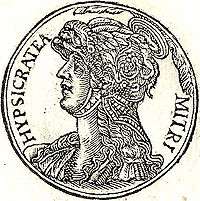
_01.jpg)



